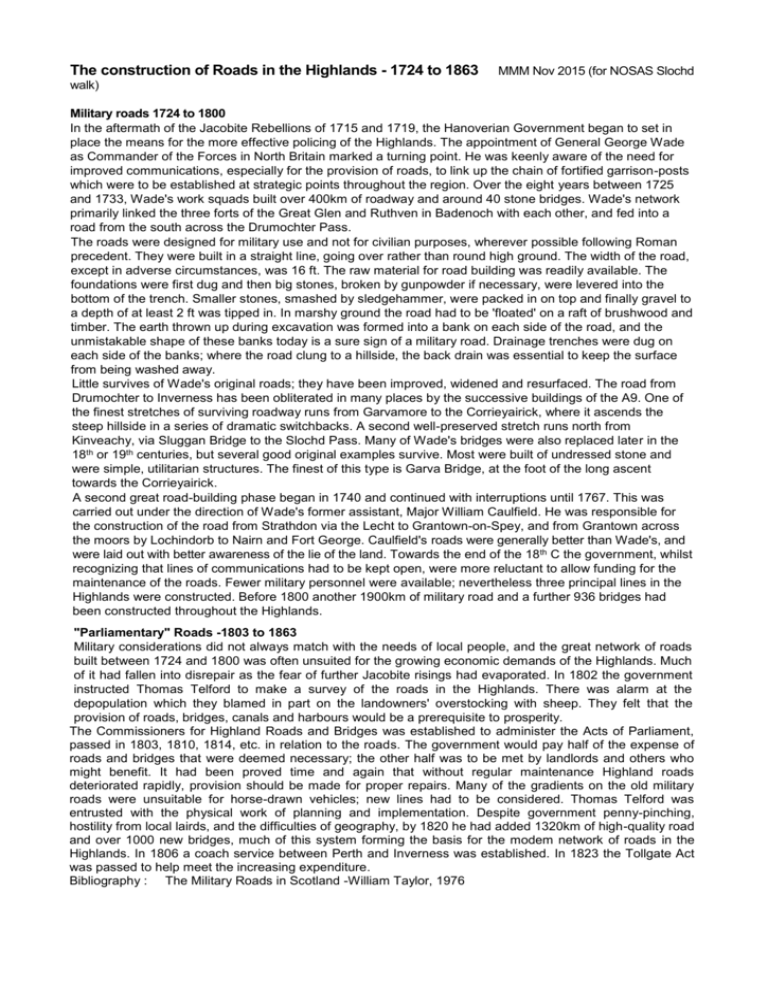The construction of Roads in the Highlands
advertisement

The construction of Roads in the Highlands - 1724 to 1863 MMM Nov 2015 (for NOSAS Slochd walk) Military roads 1724 to 1800 In the aftermath of the Jacobite Rebellions of 1715 and 1719, the Hanoverian Government began to set in place the means for the more effective policing of the Highlands. The appointment of General George Wade as Commander of the Forces in North Britain marked a turning point. He was keenly aware of the need for improved communications, especially for the provision of roads, to link up the chain of fortified garrison-posts which were to be established at strategic points throughout the region. Over the eight years between 1725 and 1733, Wade's work squads built over 400km of roadway and around 40 stone bridges. Wade's network primarily linked the three forts of the Great Glen and Ruthven in Badenoch with each other, and fed into a road from the south across the Drumochter Pass. The roads were designed for military use and not for civilian purposes, wherever possible following Roman precedent. They were built in a straight line, going over rather than round high ground. The width of the road, except in adverse circumstances, was 16 ft. The raw material for road building was readily available. The foundations were first dug and then big stones, broken by gunpowder if necessary, were levered into the bottom of the trench. Smaller stones, smashed by sledgehammer, were packed in on top and finally gravel to a depth of at least 2 ft was tipped in. In marshy ground the road had to be 'floated' on a raft of brushwood and timber. The earth thrown up during excavation was formed into a bank on each side of the road, and the unmistakable shape of these banks today is a sure sign of a military road. Drainage trenches were dug on each side of the banks; where the road clung to a hillside, the back drain was essential to keep the surface from being washed away. Little survives of Wade's original roads; they have been improved, widened and resurfaced. The road from Drumochter to Inverness has been obliterated in many places by the successive buildings of the A9. One of the finest stretches of surviving roadway runs from Garvamore to the Corrieyairick, where it ascends the steep hillside in a series of dramatic switchbacks. A second well-preserved stretch runs north from Kinveachy, via Sluggan Bridge to the Slochd Pass. Many of Wade's bridges were also replaced later in the 18th or 19th centuries, but several good original examples survive. Most were built of undressed stone and were simple, utilitarian structures. The finest of this type is Garva Bridge, at the foot of the long ascent towards the Corrieyairick. A second great road-building phase began in 1740 and continued with interruptions until 1767. This was carried out under the direction of Wade's former assistant, Major William Caulfield. He was responsible for the construction of the road from Strathdon via the Lecht to Grantown-on-Spey, and from Grantown across the moors by Lochindorb to Nairn and Fort George. Caulfield's roads were generally better than Wade's, and were laid out with better awareness of the lie of the land. Towards the end of the 18th C the government, whilst recognizing that lines of communications had to be kept open, were more reluctant to allow funding for the maintenance of the roads. Fewer military personnel were available; nevertheless three principal lines in the Highlands were constructed. Before 1800 another 1900km of military road and a further 936 bridges had been constructed throughout the Highlands. "Parliamentary" Roads -1803 to 1863 Military considerations did not always match with the needs of local people, and the great network of roads built between 1724 and 1800 was often unsuited for the growing economic demands of the Highlands. Much of it had fallen into disrepair as the fear of further Jacobite risings had evaporated. In 1802 the government instructed Thomas Telford to make a survey of the roads in the Highlands. There was alarm at the depopulation which they blamed in part on the landowners' overstocking with sheep. They felt that the provision of roads, bridges, canals and harbours would be a prerequisite to prosperity. The Commissioners for Highland Roads and Bridges was established to administer the Acts of Parliament, passed in 1803, 1810, 1814, etc. in relation to the roads. The government would pay half of the expense of roads and bridges that were deemed necessary; the other half was to be met by landlords and others who might benefit. It had been proved time and again that without regular maintenance Highland roads deteriorated rapidly, provision should be made for proper repairs. Many of the gradients on the old military roads were unsuitable for horse-drawn vehicles; new lines had to be considered. Thomas Telford was entrusted with the physical work of planning and implementation. Despite government penny-pinching, hostility from local lairds, and the difficulties of geography, by 1820 he had added 1320km of high-quality road and over 1000 new bridges, much of this system forming the basis for the modem network of roads in the Highlands. In 1806 a coach service between Perth and Inverness was established. In 1823 the Tollgate Act was passed to help meet the increasing expenditure. Bibliography : The Military Roads in Scotland -William Taylor, 1976




